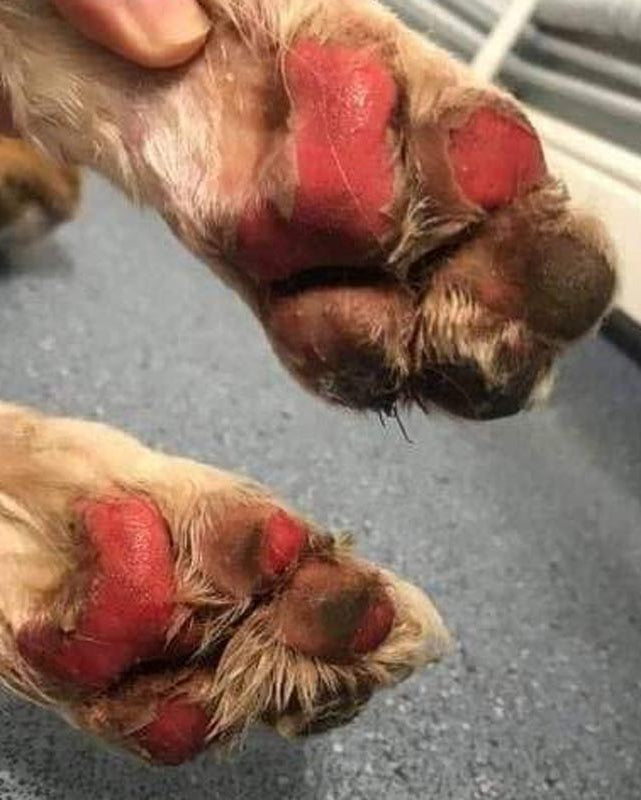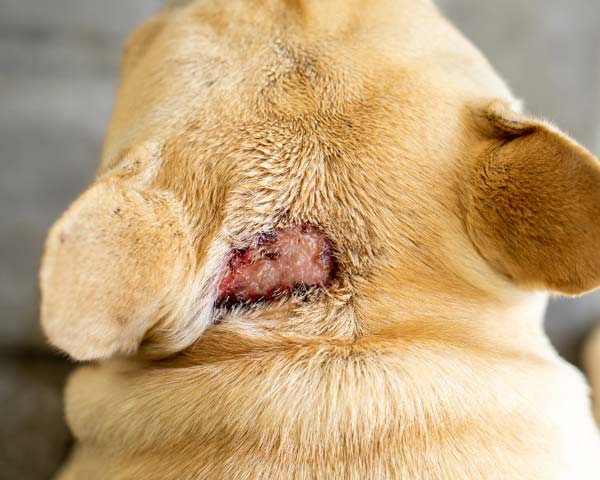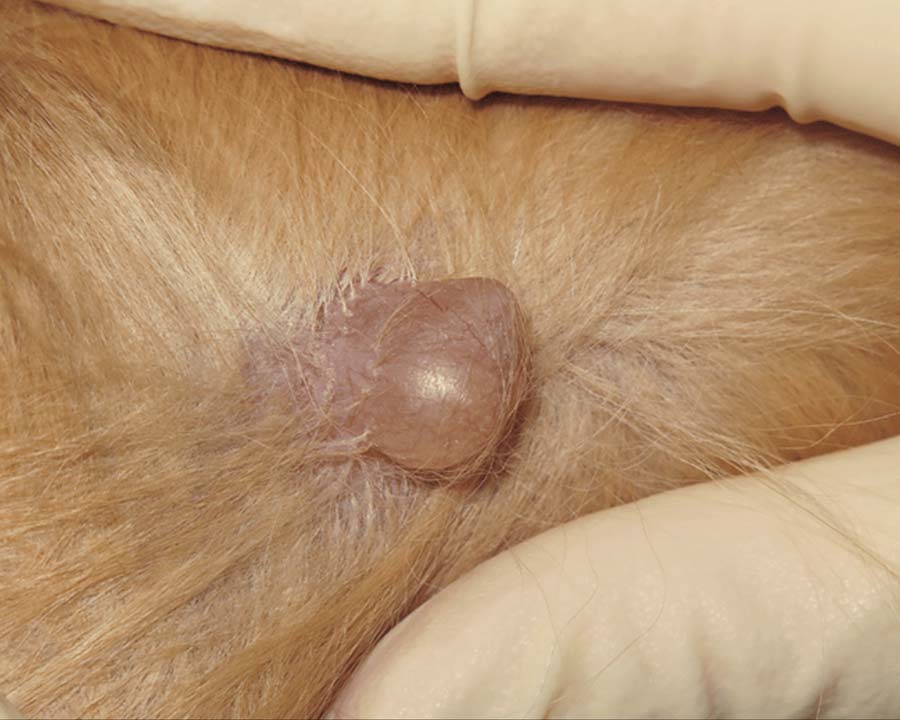Burns in Dogs + First Aid for Burnt Paws and Skin
Remember, this is an educational resource, not a guide for diagnosis.
Pictures are helpful, but they may not tell the whole dermatological story. We always recommend consulting with your vet for any of your dog's health concerns.
What Causes a Burn?
A burn is a type of skin wound. They are exceptionally different than other wounds, having their own classification and medical specialty. Common types of burns include:
- Thermal burns: Due to heat from fire (including fireworks), steam, smoke
- Mechanical burns: Due to friction, such as from a rope, leash, concrete, or other abrasive surface
- Electrical burns: Due to direct exposure to electricity from exposed wiring or lightning
- Chemical burns: Due to contact with harmful substances or their fumes, such as acid, cleaners, or gasoline
A great majority of burns in dogs are from heating pads, fire, stoves, mufflers, space heaters, etc. Burnt paw pads from walking on excessively hot surfaces are another common instance.
What Makes Burns Different?
Burns not only directly damage the local skin area, but they can cause other generalized effects on the body. They may involve all layers of skin, as well as structures beneath, such as muscle, bone, blood vessels, nerves, and hair follicles.
Extensive burns put an immense amount of stress on the body's immune system and organs. Damaged skin cannot protect from infection or regulate body temperature. Loss of blood and vessels can impact blood pressure, which can have a serious effect on the heart, kidneys, and other internal organs.
The 3 Degrees of Burns
Burns are categorized by the amount of tissue layers that have been damaged, as well as the area covered. They are generally put into 3 categories:
- Superficial (1st-degree) burns only involve the epidermis - or outer layer of skin. They result in pain and redness, but they tend to heal quickly.
- Partial thickness (2nd degree) burns reach below the epidermis to the dermis. Partial thickness burns can bring swelling, deep redness, yellow lesions, blistering, and drainage, and come with a high risk of infection.
- Full-thickness (3rd-degree) burns affect all layers of the skin, as well as subcutaneous (fat) tissue. Burned areas may be black, brown or white, and the skin may look leathery. Third-degree burns can destroy nerves, causing numbness.

Burns and Bacteria, the Real Danger
Burned skin and tissue are at an extremely high risk of bacterial (pyoderma) and yeast infection after an initial, brief sterile period. With local immune cells and pathways damaged or destroyed, there is no defense against invasion and the multiplication of harmful microbes.
Infections can set in quickly and spread to other parts of the body, creating a systemic infection that can be fatal. Bacterial biofilms (tough, glue-like barriers that protect the bacteria) can form in a wound within a few hours, making the infection much more difficult to eliminate. In humans (we do not have data for canines), it has been reported that 75% of all burn patient deaths are related to infection.
This is an area where Lavengel® has great potential. According to a burn study performed at Wake Forest University, Lavengel® demonstrated that it not only outperforms silver in healing deep partial thickness burns, but it can also greatly inhibit and kill the microbes that cause infection.
Photo: Multi-layer paw pad burns, via the National Narcotic Detector Dog Association
Treating a Minor Burn on Your Dog at Home
Many minor, superficial burns can be treated at home. However, it is always a good idea to seek a veterinary opinion, as the burn's severity may not always be apparent at first. If you are unsure (or even if you are), we always recommend seeking veterinary care.
Quickly rinse the area with cool water, gently pat dry with a soft cloth, and apply a layer of Lavengel®. It will help relieve the sting and irritation, protect against bacteria, and heal the burned skin by keeping it hydrated and providing the micronutrients essential for repairing tissue. Plus, it's safe, even if dogs lick it off.
To further assist with the mending and guard the burn, spread a layer of Lavengel® on a soft gauze bandage and cover the wound. Your dog may try to lick the area in an attempt to heal it, so keep an eye on them. Use a cone if necessary.
Check the wound every 12-24 hours. Reapply the gel and a clean bandage as needed.
Treating Your Dog's Burnt Paw Pad at Home
First, wash the paw with cool water, and carefully clear away any dirt or debris, checking between pads. Gently apply a layer of Lavengel® to the entire pad.
Grab a gauze bandage and apply a layer of gel to the area that will be in contact with the burn, then wrap the foot. Though Lavengel® should provide significant relief from the sting of the burn, you may consider booties or a cone to prevent your dog from agitating the bandage.
If your dog has been walking on an excessively hot surface (e.g. asphalt in the summer) and all of their pads appear hot and inflamed, rinse them with cool water. You can apply a thin layer of gel to the pads to help soothe them.
As a general rule for summer, use booties or have them walk in the grass to protect their paws, keep ample water nearby, and do not let them stay out in the sun for too long.
Severe Burns: Veterinary Care
More substantial burns will require veterinary attention, and your vet will need to know what caused the burn (fire, heating pad, stove, etc.) and the length of exposure to the heat source. If your pet has any medical history, this will also need to be related to your vet.
Smoke and chemical fume inhalation is another major factor to consider, as this can increase the risk for internal problems. Be sure to let your veterinary team know if your dog inhaled smoke or chemical fumes.
From there, your vet may recommend running bloodwork to assess internal organs, blood protein levels (these tend to drop in serious burn cases), and electrolyte levels (dehydration is likely).
Blood pressure will be monitored to evaluate any fluid loss, and fluid therapy will be administered to counter dehydration. Imaging (x-ray, ultrasound, CT scan) may be suggested to check the heart and respiratory tract, especially if smoke inhalation occurred.
As mentioned previously, burn wound infection is a major threat to the health of the victim. If your dog's burn seems to be infected, your vet may suggest collecting a sample of the bacteria. These will be identified, and different antibiotics will be tested against the sample bacteria to determine the most effective antibiotics for your dog.
This can also lower the chance of an antibiotic resistant infection, such as methicillin-resistant Staphylococcus pseudintermedius (MRSP, the dog version of MRSA). As a side note and light plug, Lavengel® has a patent for its effectiveness against Staph bacteria, including both MRSA and MRSP.
Be sure that you give your dog the complete amount of antibiotic medications prescribed by your vet. Failing to do so may involve the infection returning more resistant than before. Your vet may also prescribe oral medications to reduce pain and anxiety.
Severe burns may take weeks or months to heal, and complications can happen. Once home, daily wound therapy may involve monitoring the wound, cleaning the wound, and changing bandages.

Preventing Canine Burns
We can't prevent all accidents, but several things you can do to greatly reduce the risk of your dog receiving a burn are:
- Keep them away from the stove or grill when you're cooking.
- Do not leave them unsupervised around lit candles or fireplaces.
- Keep them away from fireworks (most dogs will do this themselves, but still).
- Store all chemicals out of their reach, and keep them away when you're using them.
- Keep electrical cords away from puppies that may try to chew them.
- Do not let your pet lie directly on a heating pad, nor allow them to use it for long periods at a time.
- Check that dryer for small dogs (or cats) before turning it on.
- Use booties or avoid walking on unbearably hot/cold surfaces for long.
- Keep pets inside during times of extreme hot or cold.
Photo: Heating pad burn with infection on dog's back
Super Soothing Skin + Wound Salve for Dogs
Lavengel® is a powerful, soothing cream that quickly relieves irritated skin affected by hotspots, wounds, rashes, infections, bug bites, sores + more.
Free standard shipping on orders over $35
30-day money back guarantee
For every unit sold, we donate to help dogs + heroes








Learn About More Dog Skin Problems
-

Canine Hot Spots
They are not acute sightAlso called acute moist dermatitis, these angry red patches appear quickly, itch fiercely, and grow worse as your dog licks and scratches.
-

Rashes + Dermatitis
It's a dog rash bashIn this general overview, we look at 11 different forms of canine dermatitis and rashes, ranging from atopic (allergy) to seborrhea.
-

Cysts
You know you can't re-cystThese pesky pockets of semi-fluid matter aren't necessarily itchy, but they can be unsightly, grow slowly, and become a problem over time.
Collapsible content
Resources on burns
Burn Study:
Brian Michael Cartwright, Sean James Fox, Mary Jane Underdown, William Andrew Clark, and Joseph Andrew Molnar; 2023: Published by: Antioxidants, 2023, Volume 12, Issue 6, 1176.
Lavengel® Patent (US10912759B2, via Google Patents):
Topical Gel Compositions for the Treatment of Staphylococcal Infections
Other Sources:



